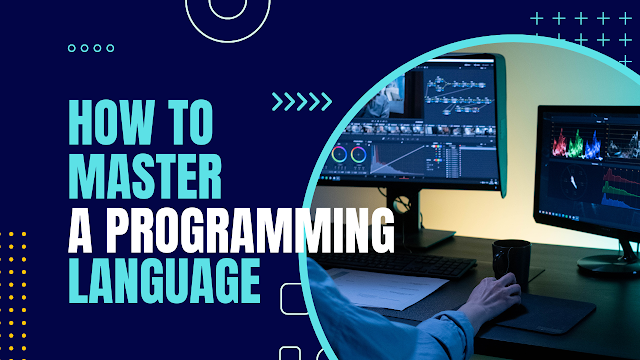Mastering a Programming Language: A Step-by-Step Guide to Effective Learning
In the rapidly evolving world of technology, the ability to code has become an increasingly valuable and sought-after skill. Whether you're aspiring to become a professional developer or simply want to expand your digital literacy, learning a programming language can open up a world of opportunities. However, the process of mastering a programming language can seem daunting, especially for beginners. In this comprehensive guide, we'll walk you through a structured approach to effectively learn and master a programming language.
Step 1: Choose the Right Programming Language
The first step in your learning journey is to select the programming language that aligns with your goals and interests. Consider factors such as the language's popularity, job market demand, and its applicability to the type of projects you'd like to work on.
Some of the most widely used and beginner-friendly programming languages include Python, JavaScript, Java, and C++. Research the features, syntax, and use cases of each language to determine which one best fits your needs and preferences.
Step 2: Establish a Strong Foundation
Once you've chosen your programming language, it's time to start building a solid foundation. Begin by familiarizing yourself with the language's syntax, data types, and control structures. This foundational knowledge will serve as the building blocks for your further learning.
Invest time in understanding the language's core concepts, such as variables, functions, loops, and conditional statements. Practice writing simple programs and experiment with different coding techniques to reinforce your understanding.
Step 3: Practice, Practice, Practice
Consistent practice is the key to mastering a programming language. Set aside dedicated time each day to work on coding exercises, small projects, and problem-solving challenges. This hands-on experience will help you develop a deeper understanding of the language and improve your problem-solving skills.
Utilize online resources such as coding platforms, tutorials, and coding challenges to find relevant exercises and projects that align with your learning goals. As you progress, gradually increase the complexity of the tasks you undertake, challenging yourself to tackle more advanced problems.
Step 4: Understand the Language's Ecosystem
Programming languages rarely exist in isolation. Each language has its own ecosystem of libraries, frameworks, and tools that can enhance your development capabilities. Familiarize yourself with the most popular and widely used frameworks, libraries, and tools associated with your chosen language.
For example, if you're learning JavaScript, you might explore frameworks like React, Angular, or Vue.js, as well as popular libraries such as jQuery or D3.js. Understanding the language's ecosystem will not only broaden your skillset but also make you a more versatile and valuable developer.
Step 5: Stay Up-to-Date with Industry Trends
The world of programming is constantly evolving, with new technologies, frameworks, and best practices emerging regularly. To stay ahead of the curve, make a habit of keeping up with industry trends, news, and developments related to your programming language.
Follow influential developers, programming communities, and industry publications to stay informed about the latest advancements. Attend online or in-person events, such as webinars, conferences, or local meetups, to learn from experienced developers and network with like-minded individuals.
Step 6: Contribute to the Developer Community
Engaging with the developer community can be a powerful way to enhance your learning and grow as a programmer. Participate in online forums, such as Stack Overflow or Reddit's programming subreddits, to ask questions, share your knowledge, and learn from the experiences of others.
Consider contributing to open-source projects, which not only allows you to apply your skills in a real-world setting but also exposes you to diverse coding practices and collaboration workflows. Participating in hackathons or coding challenges can also provide valuable hands-on experience and networking opportunities.
Step 7: Seek Feedback and Mentorship
As you progress in your learning journey, seeking feedback and guidance from experienced developers can be incredibly beneficial. Identify potential mentors, whether through your personal network, online communities, or professional organizations, and actively seek their advice and feedback.
Mentors can provide valuable insights, point out areas for improvement, and offer practical guidance to help you overcome challenges and accelerate your learning. Don't be afraid to ask questions, share your work, and incorporate their feedback into your ongoing development.
Step 8: Embrace a Lifelong Learning Mindset
Mastering a programming language is not a one-time achievement; it's an ongoing process of continuous learning and growth. As technology evolves and new tools and techniques emerge, be prepared to adapt and expand your skillset.
Cultivate a growth mindset, embrace new challenges, and stay curious about the latest developments in your chosen programming language. Regularly review your progress, identify areas for improvement, and set new learning goals to keep yourself motivated and engaged.
Conclusion
Learning a programming language is a journey that requires dedication, persistence, and a willingness to learn. By following this step-by-step guide, you'll be well on your way to mastering a programming language and unlocking a world of opportunities.
Remember, the key to success is consistent practice, a thirst for knowledge, and a commitment to continuous improvement. Embrace the process, celebrate your victories, and never stop learning. With these strategies in your toolkit, you'll be empowered to become a skilled and confident programmer, ready to tackle any challenge that comes your way.

